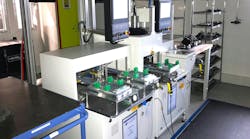SAN JOSE, Calif. — Pilots of the future F-35 Joint Strike Fighter (JSF) will wear different helmet-mounted displays, depending on which variant of the stealth fighter they fly.
British Navy and Air Force pilots of the F-35B will wear helmet-mounted displays (HMDs) from BAE Systems Platform Solutions, in Rochester, England. That version of the aircraft is designed for short takeoff and vertical landing (STOVL).
Pilots of the F-35A and F-35C variants — customized for U.S. Air Force and Navy missions — will use an HMD designed by Vision Systems International (VSI) in San Jose, Calif. The F-35A is designed to exceed the flight capabilities of the F-16 jet fighter, while the F-35C is designed with extra strength and wing size so it can land on aircraft carriers.
Engineers at BAE will design the STOVL helmet — called the alternate HMD — according to terms of a September contract from the Lockheed Martin Aeronautics Co. of Fort Worth, Texas.
BAE leaders will deliver a prototype helmet by late 2004 and a flight-qualified helmet by late 2006, followed by flight-testing, says Larry Stone, director of communications for BAE Systems Platform Solutions in Johnson City, N.Y.
The alternate HMD will be a high-resolution, binocular system, relying on a head tracker with high-speed, high-accuracy, low-latency optics. It will display virtual head-up-display symbology and video imagery from the F-35 sensors, and will be compatible with helmet-mounted, high-resolution, night-vision cameras.
BAE designers will base the design closely on the binocular HMD they are now producing for the Eurofighter Typhoon.
The Eurofighter helmet passed a series of stringent tests, including impact and penetration to U.K. and European standards, 600-plus-knot windblast, and 600-plus-knot ejection. It also survived high "g" comfort and stability testing on the Hawk and Gripen aircraft, BAE says.
That helmet integrates its optoelectronics and life-support functions, including a respirator to protect the pilot from nuclear, biological, and chemical contamination.
In contrast, designers at VSI are building the main HMD for JSF pilots, under an $84.65 million contract awarded by Lockheed Martin in 2003.
VSI engineers will deliver more than 3,000 HMD units for the JSF development and integration laboratories, flight simulators, and flight-test platforms. They are also planning for future full-rate production.
VSI is a joint venture between EFW Inc., a subsidiary of Elbit Systems, Haifa, Israel, and Rockwell Collins, Cedar Rapids, Iowa. Formed in 1996, VSI is also producing the Joint Helmet Mounted Cueing System (JHMCS) for the F-15, F/A-18, and F-16 tactical aircraft.




